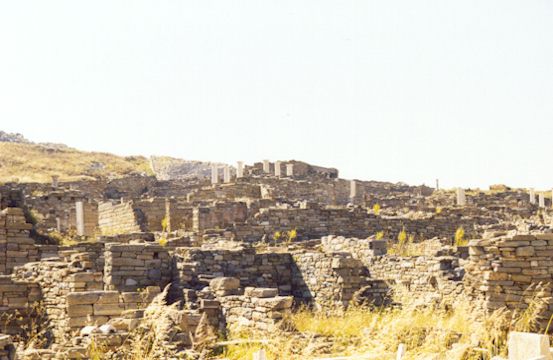 DELOS
DELOS
 |

Dilos is the sacred island of ancient times. It is located 6 n.m southwest of Mykonos. It is a very small rocky island in which, according to the myth Apollo and Artemide, were born by Lito.
The myth says that Hera cursed Lito, who was pregnant from Zeus - Hera's husband - to give birth in an island hidden from the sun. Lito wondered around and suffered until Poseidon felt sorry for her and revealed an island from the depths of the sea. Dilos, that means obvious, was a small shiny island. Apollo and Artemide were born there. This island was the religious and cultural center of ancient times.
Dilos was inhabited by Ions during the 10th century BC. Around 7th century BC the island developed into a powerful religious and trade center. Its geographical position, in the center of Aegean Sea, had to do a lot with this development.
In 478BC the residents of Athens made the first partnership with Dilos and accomplished to dominate in Aegean islands. During this partnership the residents of Athens decided - in 540BC - to transfer the bones of their dead to the small island of Rinia. Later at this time they forbid to give birth to children and die on this sacred island.
In 315 BC Macedonians end the domination of Athens. The island then has some kind of independence and starts to develop trade. When Romans come, Dilos flourishes. It is then that people of different nationalities, come to the island.
In 88 BC during the mithridatic war Dilos is set on fire. Since then it hasn't been inhabited again.
Dilos remains the sacred island of Cyclades with very important antiquities. To be more specific the whole island is an archaeological site.
Every day boats from Mykonos take people to admire this wonder of antiquity.
Among them, the Stadium, the remains of ancient temples (Apollo, Artemide's, Iris's), Oikos Naxion. Temples of foreign gods such as the sacred of Isida and Serape, worshipped by Egypts, the sacred of Syrian gods and that of Kaviron, show that all these nationalities lived in Dilo.
The most important buildings and temples you will see in the island are: the Market of Kobetaliaston that is next to the port. It is one of the most important markets in the hellenistic town. It dates back to the end of the 2nd centuryBC. In the north side of it, you can see the remains of Phillip's arcade and an Ion temple dedicated to Hermes.
The temple of Dilion is the biggest of the three temples dedicated to Apollo. It is of doric style with six columns in every narrow side and 13 in every long side of it.
Its construction began in 478BC. But when the cashier of the Athenaeum partnership transferred in Athena, the structures stopped. During the period of the Dilian Independence an effort was made to continue it, but unfortunately it never completed.
Andiro of Lions is the most photographed of all in the island. They are the famous, made of marble, lions standing in row to keep the sacred lake safe (which is now drained). The lions are dedicated from the residents of Naxos and date back to the 7th century. At first there were 16, but now only five of them are saved and parts of three others, while the headless body of another lion is in the Dockyard of Venice.
Dioniso's residence, is a typical sample of the ancient residences in Dilo.It dates back to the 2nd century. It was named after the famous mosaic-work in the yard that shows Dioniso on a panther.
In the center of the yard is an underground water tower with a floor mosaic, where the water from the rain is gathered. A stone staircase leads to the first floor.
|
|



